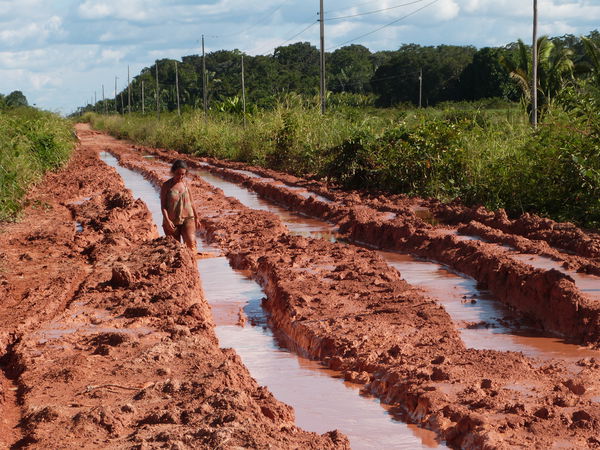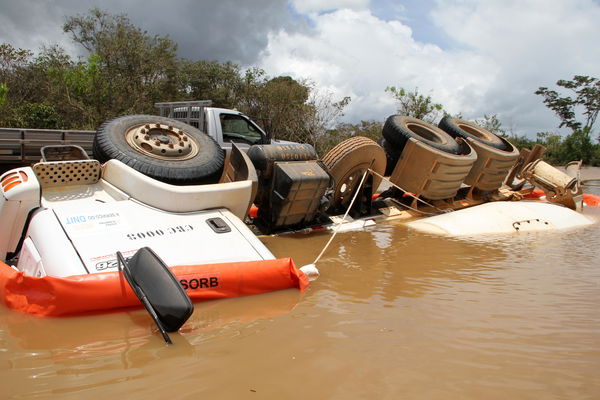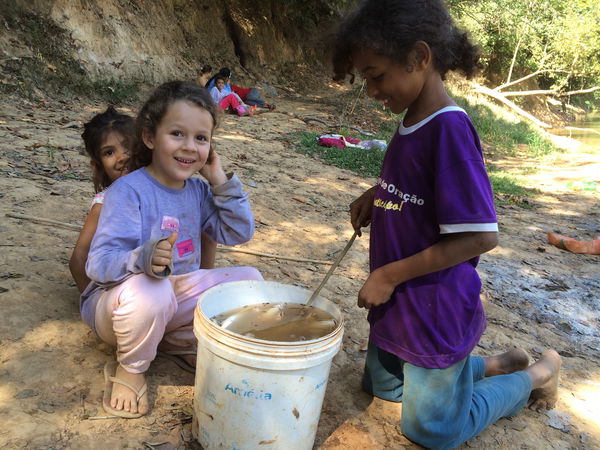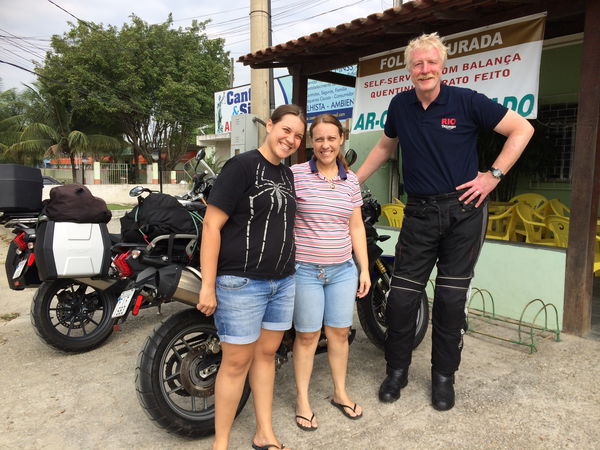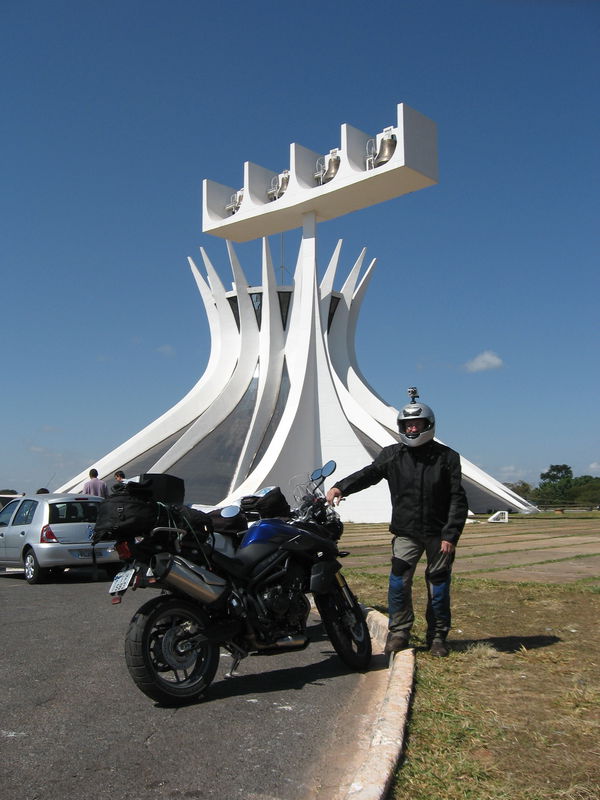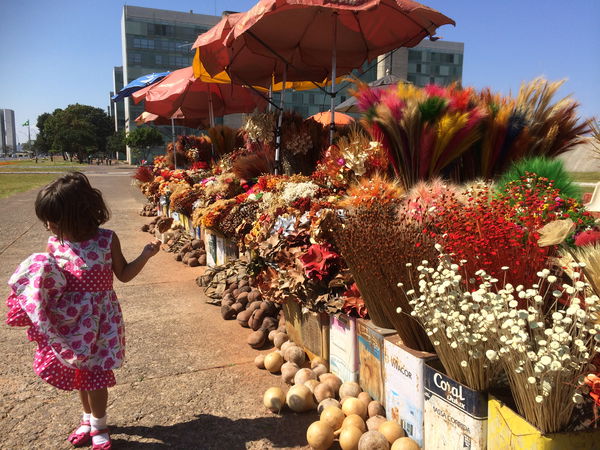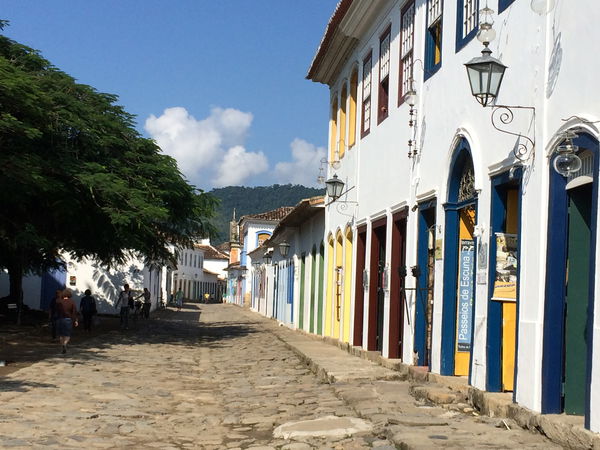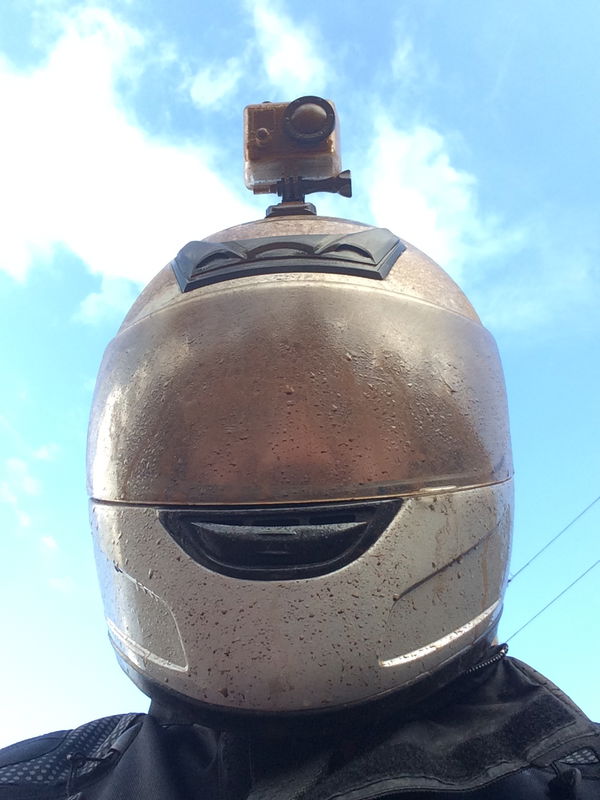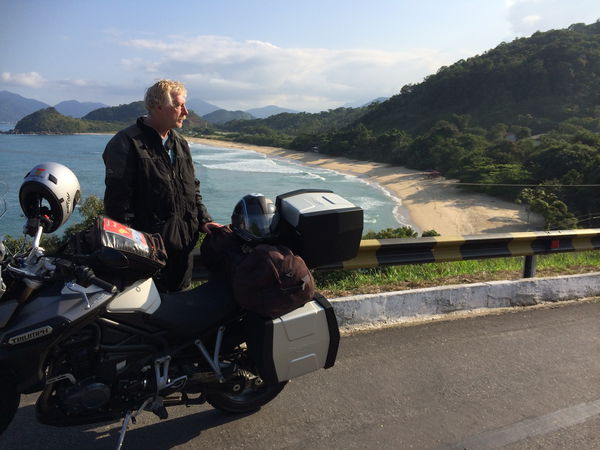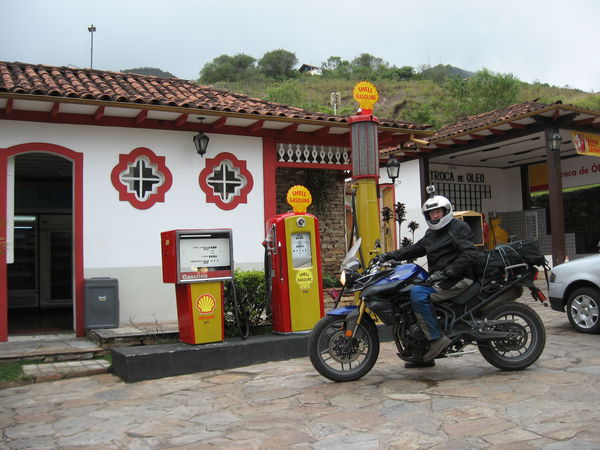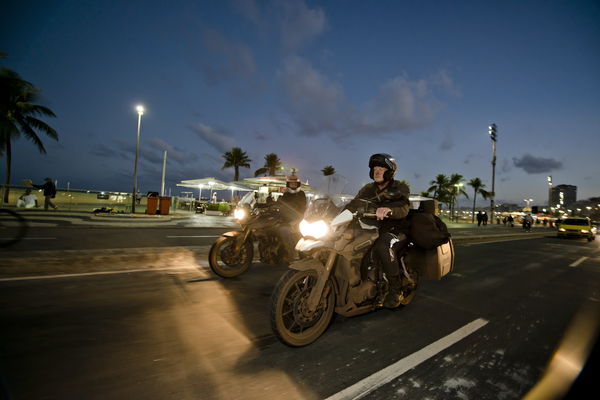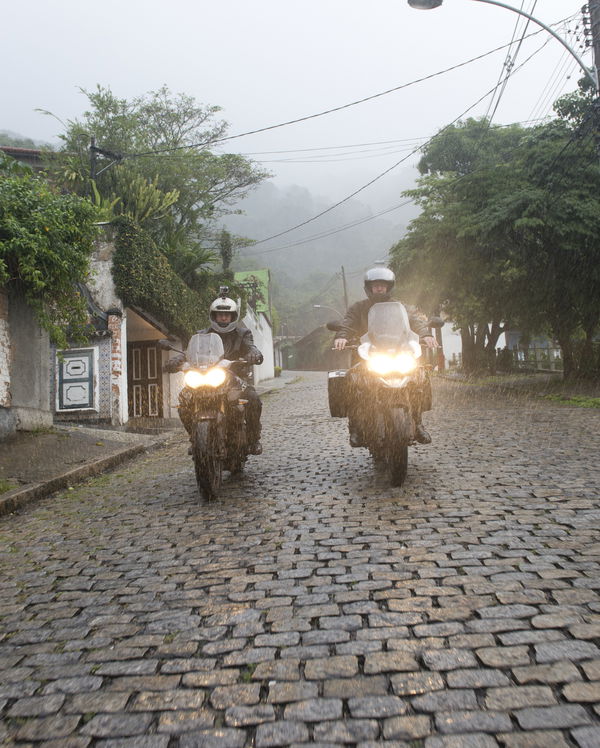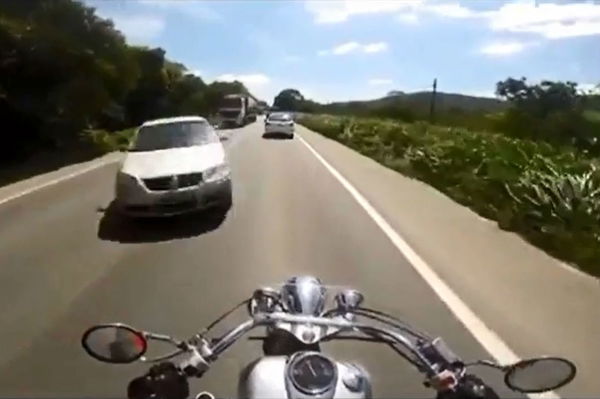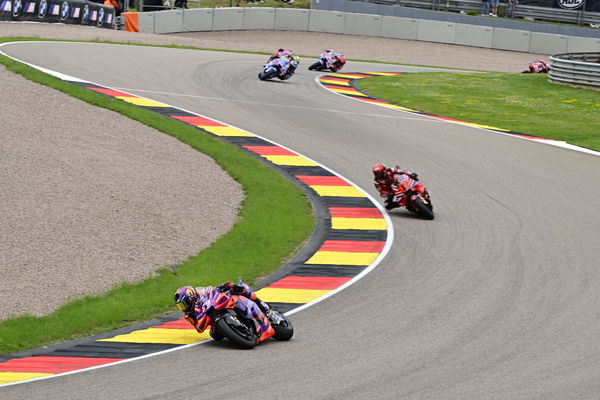Brazil: Not so great at football, still fantastic for a motorcycle adventure
We’re not big followers of football here at Visordown but we admit being slightly heartbroken today for Brazil, having paid $11bn to stage a World Cup that ended in utter humiliation.
But, as Geoff Hill discovered on a recent ride through the country, Brazil has much to take pride in besides football.
Hill, round-the-world adventurer and Daily Mirror motorcycle correspondent, toured Brazil by Triumph Explorer on the eve of the World Cup. Here’s his travelogue.
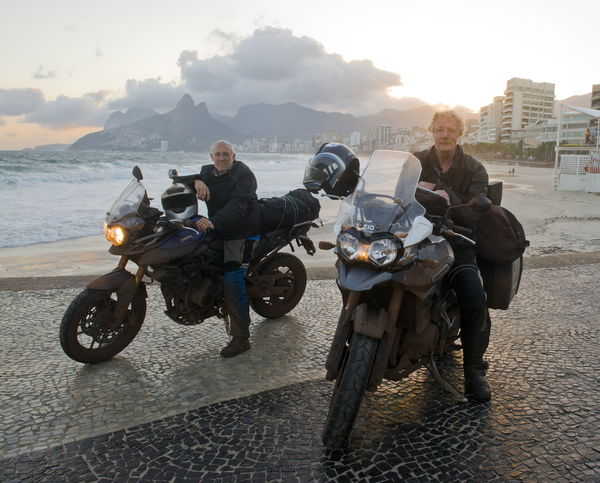

WE were in Brazil. We had two Explorers fresh from the new Triumph factory in Manaus deep in the Amazon jungle, full tanks of gas, half a packet of Werther’s, it was dawn and we were wearing sunglasses.
We were all set to hit the road for the 2,600 miles to Rio, except for one small problem.
There was no road to hit. Five hundred miles of it had been washed away by torrential rain.
'Here, what idiot organised this in the middle of the rainy season?' I muttered plaintively to my mate Peter.
'You did.'
I sighed deeply, for what I suspected was not going to be the last time.
You see, no matter how many adventures I organised, I was still crap at organising them. So far I had managed to arrive in India on the hottest day of the year, leave Ireland in three feet of snow, turn up in Holland in the coldest spring since 1922 and arrive in Sri Lanka in the middle of the monsoon.
I sighed again, and phoned Ed, the man from Triumph UK.
'Tell you what,' said Ed. 'Fly to Rio, pick up two bikes from the dealer, and I’ll work out a nice route from there.'
And so, finally, we were off, our plan not only to discover an undiscovered biking destination, but to see if the locals were looking forward to the first World Cup to be held there since 1950, when a 2-1 defeat to Uruguay plunged the nation into a depression from which it took years to recover.
We arrived in Rio, and went walking on the beach, realising immediately that this is impossible to do without humming The Girl from Ipanema.
Behind the endless energy of beach volleyball and soccer, the buildings were down at heel apart from the glittering neoclassical glory of the Copacabana Palace Hotel, built in 1923 and the first to bring what was then the turboprop set flying down to Rio.
The view of the sprawling metropolis and Sugar Loaf Mountain beyond was one of the events in my life, like riding Route 66 or the Orient Express, that was every bit as good as I hoped it would be.
'Are you looking forward to the World Cup?' I said to Matthias the guide as we admired it.
'Sure am. I’ve got six tickets for the final. If Brazil’s in it, I’ll take my girlfriend, sell four and make a small fortune. If not, I’ll sell all six and make a bigger fortune,' he grinned.
The next morning, we walked through the door of Rio’s Triumph dealership to be greeted by the cheery figure of salesman Nicolay Figueroa.
'You the guys here for the Explorer and the Tiger 800?' he said, his Californian dude accent the result of two years in Santa Barbara, after which he got fed up with American women, married a Brazilian and came home.
'How are we doing? Great. We’ve been here a year and we’re selling 80 bikes a month, with the Tiger 800 the most popular. It’s the equivalent of £8,000 here, and the BMW GS800 is £11,000. The Explorer is £13,000 and the R1200GS is £18,000, and it’s like a tractor compared to the Explorer.'
'And are you looking forward to the World Cup?' I said,
'Not so much,' he shrugged. 'A month’s happiness for £10 billion which would be better spent on education.'
We shook his hand, rode nervously into the traffic, and tilted southwest along the Costa Verde, or green coast, rendered slightly less idyllic by the Petrobras oil terminal and two nuclear power stations which the military rather cleverly built in an earthquake zone.
Looking at the jungle, it was impossible to imagine the struggle the first explorers must have had hacking their way through it in cuirasses, helmets and splendid pantaloons.
Still, since they had no maps for El Dorado, they could hardly get lost.
At the roadside diner where we stopped for chicken and rice, the TV showed a freak hailstorm in Sao Paulo, just down the road, and on the other wall hung a painting of a thatched Tudor cottage and an English rose garden.
We rode on, glorying all the afternoon in a glorious symphony of sweeping curves between the mountainous jungle and the glittering ocean, and we were two happy men who rode at dusk into Paraty, an ancient colonial town of whitewashed houses, terracotta tiled roofs, a rainbow of pastel woodwork, and huge irregular cobbles which mean that everyone staggers about drunkenly, so no one notices how much you drink.
We took full advantage, dining to the strains of the resident jazz quartet at a small restaurant in the square while the local kids played basketball in front of the town’s venerable church.
The cobbles are aligned to allow rainwater to run down to the sea, and that night as we slept, the high tide returned the favour, creeping through the streets by the light of the full moon and leaving in the morning a briny tang and the body of a small, disappointed sardine whose attempt to short cut evolution had not, after all, succeeded.
We left town and rode north to Sao Paulo, through a landscape of wooded hills and lakes.
It was a more idyllic scene than Sao Paulo, which contains 20 million people, all of whom had for some reason decided to go out for a drive that day. It also contains 70 museums, 120 theatres, 50 parks and 15,000 pubs, but after laboriously filtering through traffic for two hours in baking heat, and at one stage finding a family of grazing capybara looking at us quaintly from a city centre verge, we turned tail and fled to the village of Santa Isabel an hour outside the city.
There, in the kindness typical of strangers, a local man got into his car and led us to the Pousada Lua, where a friend of the owner, who was just about to set off for eight days in Paraguay with his wife on a Honda Shadow, let us park the bikes in his garage.
Even better, it was my birthday, so Peter popped out and returned with a bottle of bubbly, a vuvuzela and a World Cup deely bopper, and then in the village restaurant, and I use the term loosely, I ordered pizza in Portuguese so badly we were served two chicken and bacon rolls.
The next day, the road north to Brasilia turned from arrow-straight motorway to fast dual carriageway then two-lane blacktop, mostly immaculate and snaking its way through a landscape that was once coffee bushes and is now maize, soya bean and finally savannah so redolent of Africa that I was only mildly surprised to see a family of giraffes on the horizon.
Sadly, they turned out to be plastic ones on top of a filling station.
In Brasilia, we found an expensive hotel with cheap soap and ate dinner at a Greek restaurant in a shopping mall owned by a slovenly German and run by Abdelteef Adman Achmed, an enthusiastic Sudanese civil engineer who was paying his way through his Masters degree, and who looked and sounded exactly like Eddie Murphy in Trading Places.
'World Cup?' he said. 'I am working too hard to watch it. Anyway, from the papers today, some of the stadiums won’t even be ready. They’re thinking of using club stadiums instead. Chaos.'
Brasilia is the Ottawa or Canberra of Brazil; a purpose-built political capital conceived by President Juscelino Kubitschek in 1956 and designed by modernist architect Oscar Niemeyer.
Ultra-modern for about 10 seconds, it’s been stuck in a time warp ever since, as we found the next morning when we went looking for its beating heart.
It was not in the empty weekend boulevards, or the faceless glass façades of the towering government buildings, which could be in Anywhere, USA.
Neither was it in Niemeyer’s Metropolitan Cathedral, its exterior a glittering white crown of thorns and its interior, with a glass ceiling of blue and green swirls, like being underwater and looking up to heaven like an aspirational sardine.
No, it was in the lake, bright with the sailing dinghies of people who had stopped being politicians or civil servants and were just happy children at play again.
'Perfect day for a spot of gentlemanly motorcycling,' I said as we set off for Belo Horizonte the next morning in glorious sunshine.
I should have kept my mouth shut.
The Explorer wasn’t enjoying Brazilian fuel, which made progress so slow that by dusk we were still an hour from Belo Horizonte.
Then the torrential rain started. And Peter’s 800 rolled off the stand, snapping the mirror and making overtaking a challenge.
Two hours later, soaked and knackered, we spotted the lights of a hotel on the outskirts of Belo Horizonte, and climbed wearily off the bikes for a hot shower, a warm meal and a very cold beer.
The next day was even worse, with more torrential rain and spray from passing lorries covering us in a layer of red mud.
But it was worth it for two things.
The town of Ouro Preto, cradled in mist and mountains, with its whitewashed buildings, ornate wrought iron balconies, pastel woodwork with the patina of age, cobbled streets and mansions and churches worthy of its status as the former state capital.
It is also the birthplace of Aleijadhinho, the 18th Century womaniser, bon vivant and sculptor, whose finest creation lies down the road at the Basilica of Bom Jesus in Congonhas: a series of statues representing the Passion of Christ and the prophets.
What is remarkable about them is not just the exquisite skill of the carving, or the infinitely gentle, infinitely suffering humanity of their faces, but the fact that by the time he carved them, Aleijadinho had been struck down by leprosy.
Crippled with pain, unable to walk or use his hands, he was carried up the hill to the Basilica every day to create his masterpiece with chisels strapped to his wrists.
Compared with that, dodgy fuel and a liberal coating of mud is a very small problem indeed.
And then, as a reward for that epiphany, on our last day the sun came out and the bike ran as sweet as a nut all the way down to Rio.
The bikes:
The Tiger Explorer and 800 were fast, flexible and unflustered by the occasional chewed up road, unseen speed bump or sandy lane to a beach for a lunchtime dip. I rode the Explorer most of the time, and the seat was a lot more comfortable than the air-cooled R1200GS I rode around the world last year.
As for the 800, riding it reconfirmed my feelings that it’s the sweetest handing middleweight adventure bike in the known universe.
‘I loved the 800 – nippy, fast, robust and great handling. It’s got the power of a 1200 and the agility of a 600,’ said long-time R1150GS and R1200GS owner Peter.
‘As for the Explorer, it’s a big, chunky beast built for long-distance adventure. Riding it, the sound’s a bit tinny, although it’s a lovely deep baritone from behind, and the panniers seem a bit flimsy compared to the ones on the R1200GS.’
The Explorer also didn't like Brazilian fuel, even the premium grades recommended by the dealer in Rio.
The 800 was fine, and the bike adventure companies who do tours in Brazil (See Getting There, below) use middleweight Beemers, which will run on anything from porridge upwards.
Getting there:
I flew with TAP Portugal, which has 82 weekly flights from the UK to 12 destinations in Brazil via Lisbon, making it the most frequent flyer to the country. Prices start at £716 return including all taxes and surcharges for return flights to Rio de Janeiro.For further information, visit www.flytap.com or call 0845 601 0932.
Several established companies organise motorcycle tours of Brazil, including Compass Expeditions, whose 14-day Best of Brazil tour is around £3,700 on BMW F700GSs, not including flights. Also Ride Adventures, which does a similar tour on F650GSs for the same price, and Brazil Motorcycle Adventures, which has a range of tours from one to 14 days from £1,900 to £4,800.
Where to stay:
Best places were the friendly and colourful Pousada Eclipse in Paraty, the Pousada Ana Doce in San Sebastião with its leafy courtyard and the lovely old Colonial Hotel in Cononghas, all with doubles from about £30, including breakfast and wi-fi.
Best places: Rio, Paraty, Ouro Preto and Congonghas.
